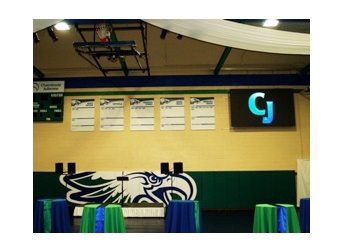The Chaminade-Julienne High School in Dayton, Ohio just received a charitable donations of two 6mm pitch NanoLumens NanoSlim LED displays for its basketball gymnasium.
According to Jeff Olich, president of Total Network Technologies, which installed the displays, the person making the donation wanted to give the school a way to showcase students’ athletic achievements and breathe new life into the gym, and the NanoLumens displays were the only way to do it.
“When the customer told me he wanted to put displays that were 100 inches or bigger in the gym, I thought it was a great idea,” he said. “Once we started looking at the architecture and lighting characteristics of the room, however, we realized that there was no way to successfully use a LCD display or a projection system. With LCD TVs maxing out under 100 inches and the lighting issues with projection systems in very bright rooms, this gym required a unique solution that could only be filled by the NanoLumens NanoSlim displays.”
The NanoLumens displays are capable of running at 1,000 nits of brightness, so they were the ideal solution for this room. The NanoSlim’s lightweight design also made the installation easier, with each 145-inch display weighing only 450 pounds, and enabling Total Network Technologies to hang them from the ceiling with aircraft cable.
And as anyone who has played sports in a gymnasium can attest to, eventually every single inch of wall space will be hit by a flying ball. The installers knew this, and it’s one more reason why they chose the NanoLumens displays.
“One of the great things about NanoLumens displays is that they are built tough, and the display panel combines dozens of ‘nixels’ that can be swapped out if one of them is damaged,” Olich continued. “The modular design is what makes it easy for the company to make displays in any size, and it helped us make the sale by telling the buyer that in case anything happens, the whole display won’t be useless. With a projector or LCD TV, one hit from a volleyball could break it beyond repair, and we don’t have that issue with the NanoSlim displays.”
Nixels are what NanoLumens calls its pixel arrays, which are individual squares that each have hundreds or thousands of LEDs, and can indeed be easily replaced if they fail. Depending on the total size, a NanoLumens display can comprise anywhere from one to hundreds of nixels.
As for the school, the administration loves the idea of having large high tech displays in the gym, where they can be used to create advertising revenue during games, show player photos and stats during pre-game, share upcoming school events at halftime and even be used during practice to show YouTube clips of exercises and drills that NBA teams use.
The displays receive content from an Apple Macbook Pro, an Apple TV and two DirecTV receivers. Using the Macbook Pro or a connected iPad, administrators can choose which content to display and can either have different content on each display or have them both use the same video feed. Total Network Technologies made sure the system was as easy to use as possible, so the all of the sources are permanently connected and always ready to go. The iPad makes it even easier, allowing the displays to be controlled from anywhere in the room while connected to the school’s WiFi network.
“I think more high schools, and especially universities, are going to start looking at technologies like NanoLumens to breathe new life into their large indoor spaces,” Olich added. “There’s so much potential for ad revenue and consumer engagement, even as an interactive map or information display, and the NanoLumens products last for 100,000 hours or more and require very little electricity compared with other displays. They’re easy to install, easy to repair, and they blow away the longevity and brightness of competitors. What’s not to love?”











